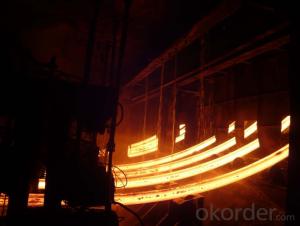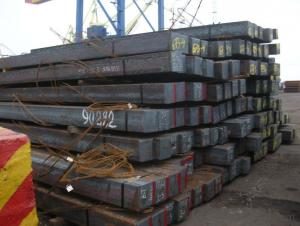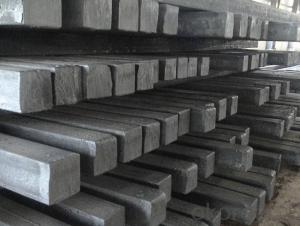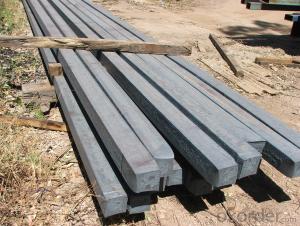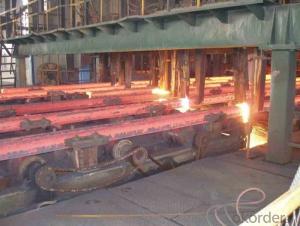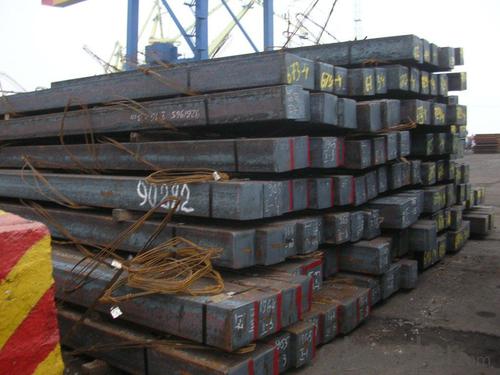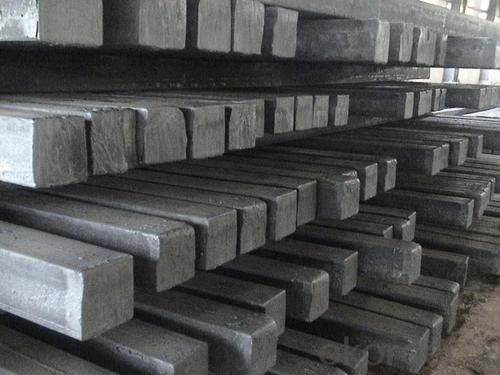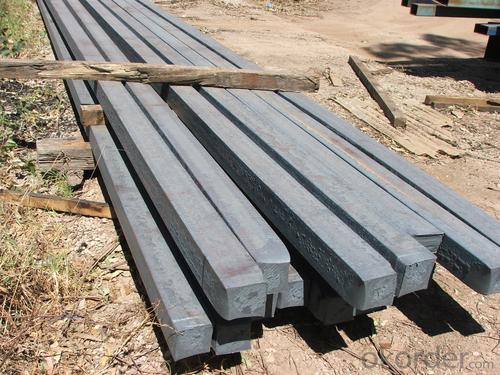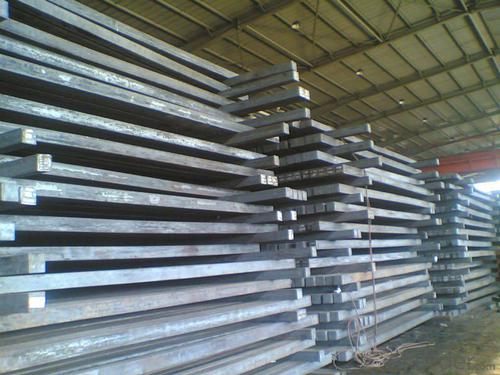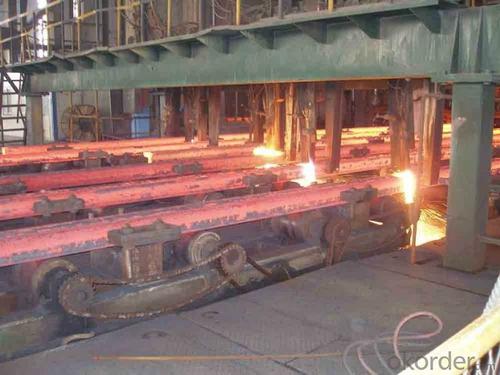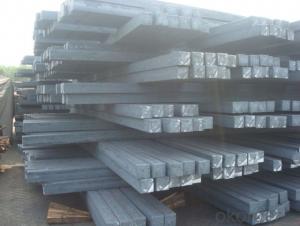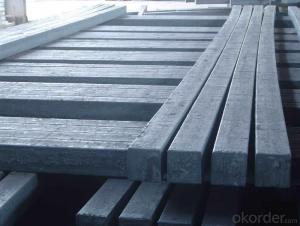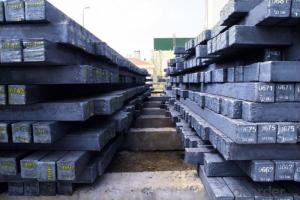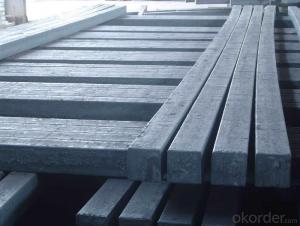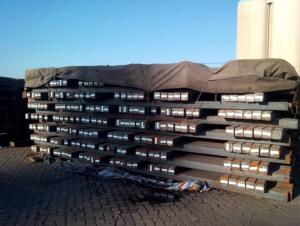Hot Rolled Square Steel Billet 3SP Standard 175mm
- Loading Port:
- Shanghai
- Payment Terms:
- TT OR LC
- Min Order Qty:
- 2000 m.t.
- Supply Capability:
- 10000 m.t./month
OKorder Service Pledge
OKorder Financial Service
You Might Also Like
Structure of Hot Rolled Square Steel Billet 3SP Standard 175mm
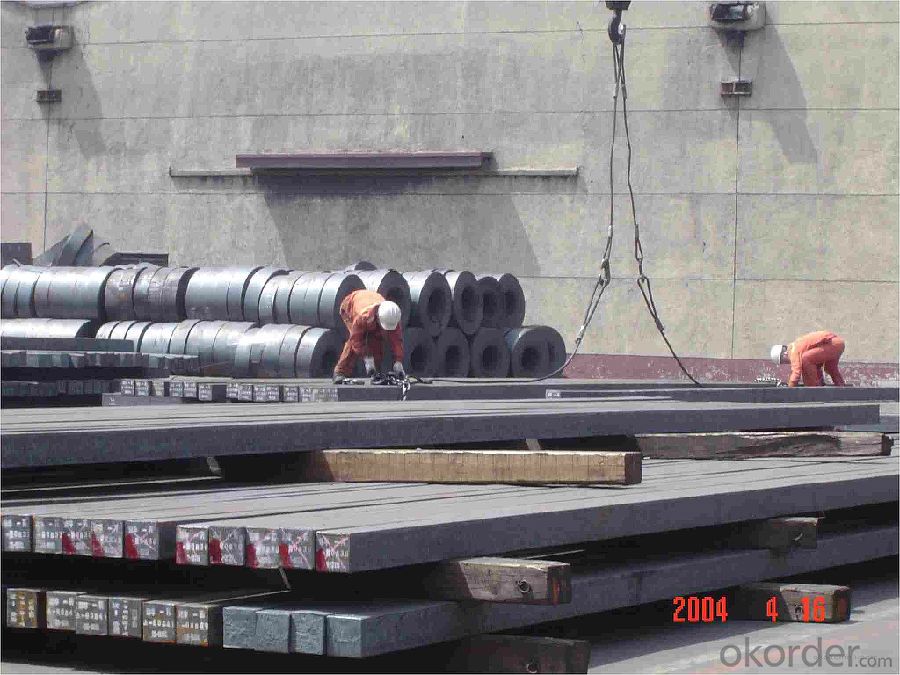
Description of Hot Rolled Square Steel Billet 3SP Standard 175mm
PPGI is made by cold rolled steel sheet and galvanized steel sheets as baseplate, through the surface pretreatment (degreasing, cleaning, chemical conversion processing), coated by the method of continuous coatings (roller coating method),
and after roasting and cooling. Zinc coating: Z60, Z80, Z100, Z120, Z180, Z275, G30, G60, G90
Alu-zinc coating: AZ60, AZ80, AZ100, AZ120, AZ180, G30, G60, G90
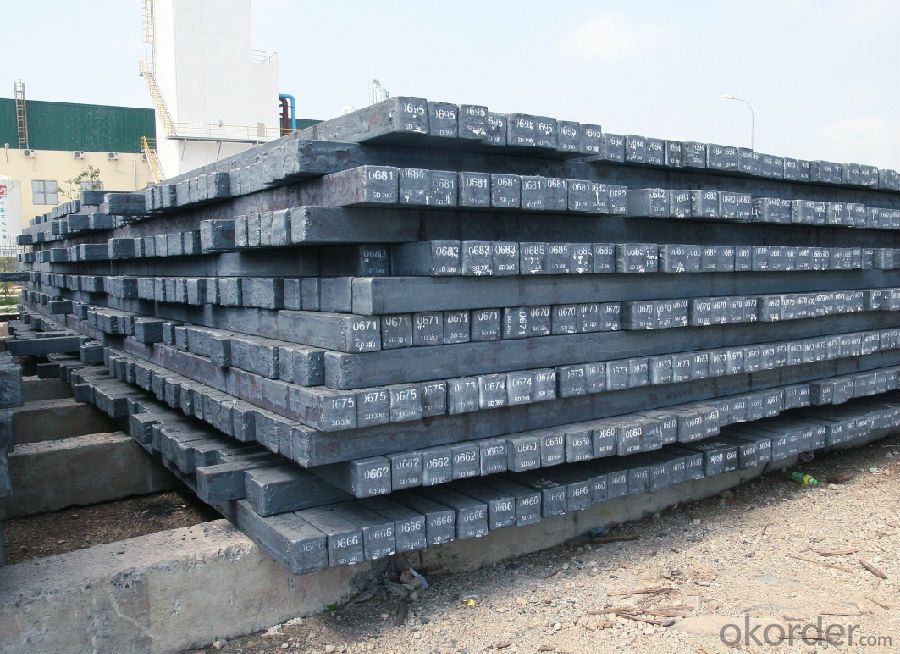
Main Feature of Hot Rolled Square Steel Billet 3SP Standard 175mm
1) Excellent corrosion resistance: The zinc layer provides a good protection of Pre-painted Galvanizeed Steel Sheet.
2) High heat resistance: The reflective surface of the material aids in efficiently reflecting the sunlight away and in turn reducing the amount of heat transmitted. The thermal reflectivity converts into energy savings.
3) Aesthetics: Pre-Painted Galvanized steel sheet is available in plethora of patterns and multiple sizes as per the requirements that given by our customers.
4) Versatility: can be used in the various areas.Standard seaworthy export packing: 3 layers of packing, inside is kraft paper, water plastic film is in the middle and outside GI steel sheet to be covered by steel strips with lock, with inner coil sleeve.
Applications of Hot Rolled Square Steel Billet 3SP Standard 175mm
1) Automotive bodies: filters, fuel tanks, etc.
2) Construction materials: roofings, welding pipes,
3) Electric and electronic appliances: computer cans, etc.
4) Steel cans: containers, etc.
5) Steel furniture: washing machines, refrigerators, microwaves, etc.
6) Drums
7) Office equipment: printer, recorders, etc.
8) Motors and transformers
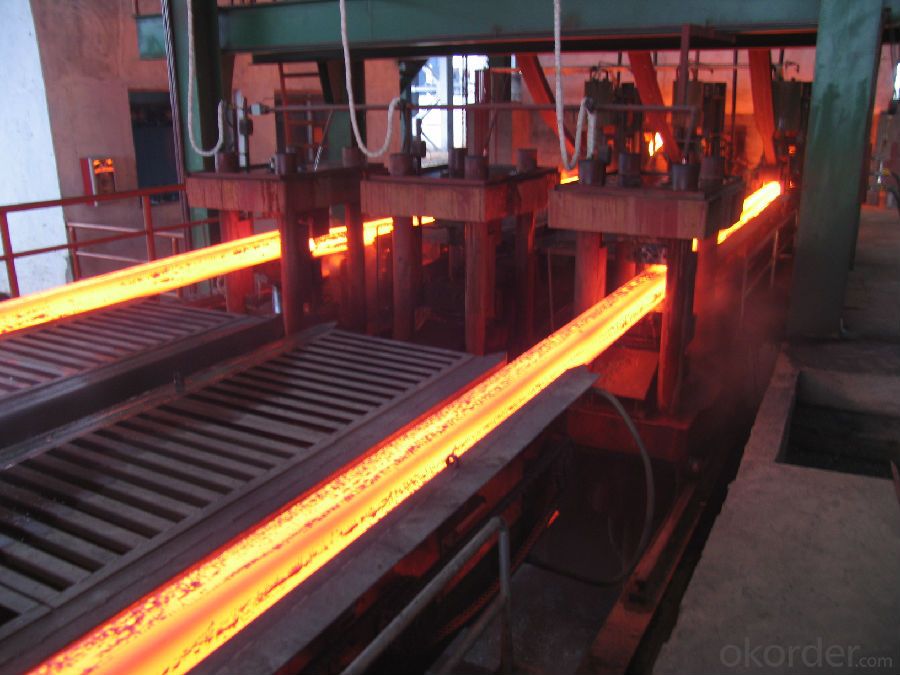
Specifications of Hot Rolled Square Steel Billet 3SP Standard 175mm
| Classified symbol | Yield Point Minimum N/mm2 | Tensile Strength Minimum | Elongation Minimum % | Application | ||||
| N/mm2 | Nominal Thickness mm (t) | |||||||
| JIS | Yogic | 0.25-0.4 | 0.4-0.6 | 0.6-1.0 | 1.0-1.6 | |||
| G3312 | specification | |||||||
| CGCC | CGCC | -205 | -270 | -20 | -21 | -24 | -24 | Commercial |
| CGCD | CGCD | --- | 270 | --- | 27 | 31 | 32 | Drawing |
| --- | CG340 | 245 | 340 | 20 | 20 | 20 | 20 | Structural |
| CGC400 | CG400 | 295 | 400 | 16 | 17 | 18 | 18 | Structural |
| CGC440 | CG440 | 335 | 440 | 14 | 15 | 16 | 18 | Structural |
| CGC490 | CG490 | 365 | 490 | 12 | 13 | 14 | 16 | Structural |
| CGC570 | CG570 | 560 | 570 | --- | --- | --- | --- | Structural |
| ASTM Designation | Yield Point Minimum | Tensile Strength Minimum | Elongation Minimum % | Application | Q/BQB 445-2004(China standard) | ASM A653/A653M | JISG 3312 | |
| ksi(MPa) | ksi(MPa) | TDC51D+Z | (CS TYPE A+Z) | CGCC | ||||
| A653(M)-99 CS TYPE A,B,C | --- | --- | --- | Commercial | TDC52D+Z | CGCD | ||
| A653(M)-99 FS | --- | --- | --- | Lock Forming | TS250GD+Z | (G250+Z) | - | |
| A653(M)-99 DS | --- | --- | --- | Drawing | TS300GS+Z | (G300+Z) | CGC 400 | |
| A653(M)-99 SS Grade33(230) | 33(230) | 45(310) | 20 | Structural | TS350GD+Z | (G350+Z) | CGC490 | |
| A653(M)-99 SS Grade37(255) | 37(255) | 52(360) | 18 | Structural | TS550GD+Z | (G550+Z) | CGC570 | |
| A653(M)-99 SS Grade40(275) | 40(275) | 55(380) | 16 | Structural | ||||
| A653(M)-99 SS Grade50(345) | 50(345) | 65(450) | 12 | Structural | ||||
| A653(M)-99 SS Grade80(550) | 80(550) | 82(570) | --- | Structural | ||||
FAQ of Hot Rolled Square Steel Billet 3SP Standard 175mm
We have organized several common questions for our clients,may help you sincerely:
1. How Can I Visit There?
Our company is located in Tianjin City, China, near Beijing. You can fly to Tianjin Airport Directly. All our clients, from home or aboard, are warmly welcome to visit us!
2. How Can I Get Some Sample?
We are honored to offer you sample.
3. Why choose CNBM?
1, ISO, BV, CE, SGS approved.
2, Competitive price and quality.
3, Efficient service team online for 24 hours.
4, Smooth production ability(50000tons/month) .
5, quick delivery and standard exporting package.
6, Flexible payment with T/T, L/C, Paypal, Kunlun bank, etc.
- Q: What are the potential applications of steel billets in the medical aftermarket?
- The medical aftermarket offers a wide range of potential applications for steel billets. One important application is the manufacture of surgical instruments, such as scalpels, forceps, scissors, and orthopedic implants. Steel billets are capable of producing high-quality and durable surgical instruments due to the strength and corrosion resistance of steel. Furthermore, steel billets are also useful in the production of medical equipment and devices. For instance, they can be used to create components for X-ray machines, CT scanners, and MRI machines. The excellent conductivity and high strength-to-weight ratio of steel make it a suitable choice for these demanding applications. In addition, steel billets can be utilized in the manufacturing of medical furniture and fixtures. Steel is commonly employed in the construction of hospital beds, examination tables, and cabinets due to its durability and ease of maintenance. Steel billets can provide the necessary raw material for the production of these essential medical items. Moreover, steel billets can also be employed in the fabrication of prosthetics and orthotics. These devices often require materials that are both strong and lightweight to ensure proper functionality and comfort for patients. Steel billets can be processed into various shapes and sizes to create prosthetic limbs, braces, and other orthopedic devices. In summary, the diverse and crucial potential applications of steel billets in the medical aftermarket cannot be underestimated. From surgical instruments to medical equipment, furniture, and prosthetics, steel billets possess the necessary qualities of strength, durability, and corrosion resistance to meet the demanding requirements of the medical industry.
- Q: What are the different surface treatments for improved surface roughness in steel billets?
- To enhance the surface roughness of steel billets, there are various surface treatments available. These treatments aim to improve the quality and properties of the billets, making them more suitable for different industrial applications. Some commonly used surface treatments for achieving better surface roughness in steel billets are as follows: 1. Shot Blasting: In shot blasting, high-speed abrasive particles are used to bombard the surface of the steel billets. This treatment effectively removes any contaminants, scale, or unevenness present on the surface, resulting in a smoother and more uniform finish. 2. Acid Pickling: Acid pickling involves immersing the steel billets in an acid solution, typically hydrochloric or sulfuric acid. This chemical treatment dissolves any oxides, rust, or scale present on the surface, leaving behind a clean and smoother surface. 3. Mechanical Grinding: Mechanical grinding employs abrasive wheels or belts to remove material from the surface of the steel billets. This treatment is particularly effective in eliminating deep scratches, pits, or irregularities, resulting in a smoother and more polished surface. 4. Electrochemical Polishing: Electrochemical polishing is an electrochemical process that combines chemicals and electrical current to remove a thin layer of material from the steel billet's surface. This treatment helps eliminate any surface imperfections, resulting in a smoother and more reflective finish. 5. Roller Leveling: Roller leveling involves passing the steel billets through a set of rollers that exert pressure on the surface, flattening and smoothing out any irregularities. This treatment is especially effective in improving the flatness and surface roughness of the billets. 6. Thermal Treatment: Thermal treatment, such as annealing, can also enhance the surface roughness of steel billets. Annealing involves heating the billets to a specific temperature and slowly cooling them to relieve internal stresses and improve the surface finish. It is crucial to consider the specific requirements of the steel billets and the desired surface roughness when selecting a surface treatment. Each treatment has its advantages and limitations, and factors such as the type of steel, dimensions of the billets, desired surface finish, and cost-effectiveness should be taken into account when choosing the most suitable treatment.
- Q: What are the potential applications of steel billets in the medical sector?
- Steel billets have a wide range of potential applications in the medical sector. One of the key uses of steel billets is in the manufacturing of medical instruments and surgical tools. The high strength and durability of steel make it an ideal material for producing instruments that require precision and reliability. From scalpels and forceps to bone saws and orthopedic implants, steel billets can be transformed into various medical tools that are essential for surgeries and procedures. Additionally, steel billets can be utilized in the production of medical equipment such as hospital beds, wheelchairs, and stretchers. These products require a sturdy and robust material to ensure patient safety and comfort. Steel provides the necessary strength to support the weight of patients and withstand regular usage, making it an excellent choice for such applications. Furthermore, steel billets can be used in the construction of medical facilities and infrastructure. Steel is known for its structural integrity, making it suitable for building hospitals, clinics, and research laboratories. Steel structures offer resistance against earthquakes, fires, and other natural disasters, ensuring the safety of both medical personnel and patients. Moreover, steel billets can be employed in the manufacturing of medical storage systems and cabinets. These storage solutions are crucial for maintaining a sterile and organized environment, preventing cross-contamination, and ensuring the proper storage of medical supplies and equipment. In conclusion, steel billets have numerous potential applications in the medical sector. From the production of surgical instruments and medical equipment to the construction of medical facilities, steel's strength, durability, and reliability make it an invaluable material in enhancing patient care and safety.
- Q: What are the specifications for stainless steel billets used in the food industry?
- Stainless steel billets used in the food industry have specific specifications to ensure safety and hygiene. These specifications primarily focus on the composition of the stainless steel, its corrosion resistance, and its ability to withstand high temperatures and aggressive cleaning agents. Firstly, the stainless steel used for food industry billets must have a high chromium content, typically ranging from 16% to 18%. This chromium content provides excellent corrosion resistance, preventing the material from reacting with food or cleaning agents. Additionally, these billets should have a low carbon content, usually below 0.08%. Low carbon stainless steel is less prone to sensitization, a process that can lead to corrosion and contamination of food products. Moreover, the stainless steel billets must comply with specific international standards, such as the ASTM A276 or EN 10088, which outline the minimum requirements for chemical composition, mechanical properties, and surface finish. Furthermore, the surface finish of the billets is crucial in the food industry. It must be smooth and free from any defects, such as pits or cracks, to prevent the accumulation of bacteria and facilitate easy cleaning. The dimensions of the billets also play a role in their suitability for the food industry. They are commonly available in square or rectangular shapes, with various sizes depending on the specific application. Lastly, these billets should be certified and compliant with industry regulations, such as those set by the Food and Drug Administration (FDA) or the European Food Safety Authority (EFSA). In summary, stainless steel billets used in the food industry must have a high chromium content, low carbon content, and comply with international standards. They should also possess a smooth surface finish, appropriate dimensions, and meet industry regulations for safety and hygiene.
- Q: What is the role of steel billets in the manufacturing of wind turbines?
- The manufacturing of wind turbines heavily relies on steel billets, which are semi-finished steel products that usually come in rectangular or square shapes. These billets are used as raw materials to produce various wind turbine components. One vital application of steel billets in wind turbine manufacturing is for constructing the tower. The tower needs to possess exceptional strength and stability to bear the weight of the entire structure and withstand wind forces. Steel's high strength-to-weight ratio makes it an ideal material for tower construction. Initially, steel billets are cut and shaped into cylindrical sections, which are then welded together to form the tower structure. This ensures the tower's robustness and ability to withstand the harsh environmental conditions faced by wind turbines. Furthermore, steel billets find usage in manufacturing other components like the rotor hub and nacelle. The rotor hub connects the blades to the main shaft, while the nacelle houses the gearbox and generator. These components require high durability and reliability to ensure optimal wind turbine performance. Steel billets are meticulously molded and machined to obtain the desired shapes for creating these components, providing the necessary strength and structural integrity. Additionally, steel billets are employed in the production of various smaller parts essential for assembling and securing different wind turbine components, such as brackets, bolts, and fasteners. To summarize, steel billets form the foundation for wind turbine manufacturing. They are transformed into strong structures and components that constitute the essential parts of these renewable energy systems. Their strength, durability, and versatility make them vital materials in wind turbine production, guaranteeing reliable operation and contributing to sustainable energy generation.
- Q: How are steel billets used in the manufacturing of construction materials?
- Steel billets are an essential raw material in the manufacturing of construction materials. These billets, which are semi-finished steel forms, serve as the starting point for various construction products such as rebars, beams, columns, and plates. In the production process, steel billets are heated and then passed through a series of rolling mills to be shaped into the desired product. For instance, when manufacturing rebars, the billet is first heated and then rolled into long, slender bars of different diameters. These rebars are widely used in construction to reinforce concrete structures, ensuring their strength and durability. Similarly, steel billets are used to create beams, columns, and plates, which are fundamental components in building construction. Beams provide structural support, while columns bear the weight of the structure and transfer loads to the foundation. Plates, on the other hand, are used for flooring, walls, and roofing applications. The use of steel billets in construction materials offers numerous advantages. Steel, known for its high strength-to-weight ratio, provides superior structural integrity, allowing for more efficient and cost-effective construction. Additionally, steel is highly ductile, meaning it can be easily shaped and molded into various forms, allowing for versatility in design and construction. Moreover, steel is a durable material that offers excellent resistance to environmental factors, such as corrosion and fire. This makes steel construction materials long-lasting and suitable for a wide range of applications, including high-rise buildings, bridges, and infrastructure projects. In conclusion, steel billets play a crucial role in the manufacturing of construction materials. By being transformed into rebars, beams, columns, and plates, these billets provide the strength, durability, and versatility required in the construction industry.
- Q: What are the different types of non-destructive testing methods used for steel billets?
- There are several different types of non-destructive testing methods used for steel billets. These methods are employed to ensure the quality and integrity of the billets without causing any damage or alteration to the material. Some of the commonly used non-destructive testing methods for steel billets include: 1. Ultrasonic Testing (UT): This method uses high-frequency sound waves to detect internal defects or inconsistencies within the steel billets. UT can identify issues like cracks, voids, and inclusions that may affect the billet's strength and performance. 2. Magnetic Particle Testing (MPT): MPT involves the use of magnetic fields and magnetic particles to detect surface and near-surface defects in the steel billets. This method is particularly effective for identifying cracks, seams, and other discontinuities that may not be visible to the naked eye. 3. Eddy Current Testing (ECT): ECT utilizes electromagnetic induction to assess the quality of steel billets. It can detect surface and near-surface defects, such as cracks and corrosion, by measuring changes in electrical conductivity and magnetic fields. 4. Visual Inspection: Visual inspection is a basic non-destructive testing method that involves a thorough visual examination of the steel billets. It aims to identify any visible defects, such as surface cracks, dents, or irregularities in shape or size. 5. Penetrant Testing (PT): PT involves applying a liquid or fluorescent dye to the surface of the steel billets. The dye seeps into any surface defects, and after a certain time, excess dye is removed, and a developer is applied to make the defects visible. This method is useful for detecting surface cracks, porosity, and other surface irregularities. 6. Radiographic Testing (RT): RT uses X-rays or gamma rays to penetrate the steel billets and produce an image that can reveal internal defects. This method is highly effective for detecting cracks, inclusions, and voids within the billets. Each of these non-destructive testing methods plays a crucial role in ensuring the quality and reliability of steel billets. By employing a combination of these techniques, manufacturers can identify any potential defects or inconsistencies and take appropriate measures to rectify them, thereby ensuring the safety and performance of the steel billets in various applications.
- Q: What is a steel billet?
- The process of casting molten steel into a rectangular shape produces a semi-finished product known as a steel billet. This billet usually has a square or rectangular cross-section and serves as the initial material for various steel products. The size of a steel billet varies depending on its intended purpose, typically ranging from 100mm to 200mm square in cross-section and several meters in length. Rolling or extrusion techniques are employed to further process these billets, forming bars, rods, wires, or structural steel sections. Steel billets are extensively utilized in the manufacturing industry as a raw material for the production of diverse steel products used across sectors such as construction, automotive, machinery, and more.
- Q: Can steel billets be used in the production of sculptures and artwork?
- Yes, steel billets can be used in the production of sculptures and artwork. Steel's strength and durability make it a popular choice for creating large outdoor sculptures or intricate metal artwork. The material can be shaped, welded, and manipulated to bring artistic visions to life, offering artists a versatile medium to express their creativity.
- Q: How do steel billets contribute to the overall safety of a structure?
- Steel billets play a significant role in contributing to the overall safety of a structure in several ways. Firstly, steel billets serve as the raw material for manufacturing steel bars, beams, columns, and other structural components. These components are widely used in construction due to their high strength and durability. By using steel billets as the starting material, the resulting steel products exhibit excellent load-bearing capacity, which enhances the structural integrity of the building. Moreover, steel billets undergo a rigorous manufacturing process that includes various quality control checks. These checks ensure that the billets possess consistent and reliable mechanical properties, such as high tensile strength and impact resistance. As a result, when these billets are used in the construction of a structure, they contribute to its overall safety by providing a reliable and robust framework that can withstand external forces, such as wind, earthquakes, or heavy loads. Additionally, steel billets are often produced using advanced metallurgical techniques, such as controlled cooling or heat treatment, to achieve specific properties required for structural applications. These processes help in improving the microstructure of the steel, reducing internal defects, and enhancing its resistance to corrosion, fatigue, and other forms of degradation. This, in turn, increases the lifespan of the structure and minimizes the risk of structural failure, thus ensuring the safety of the occupants. Furthermore, steel billets can be manufactured with precise dimensions and tolerances, allowing for accurate and efficient construction. This precision in fabrication ensures that structural components fit together seamlessly, reducing the likelihood of gaps, misalignments, or weak points that could compromise the safety of the structure. Lastly, steel billets are highly recyclable, making them an environmentally friendly choice for construction. By opting for steel billets, the construction industry can reduce its carbon footprint and contribute to sustainable development. This focus on sustainability aligns with the overall safety of a structure, as a sustainable approach ensures the long-term stability and resilience of the built environment. In conclusion, steel billets contribute to the overall safety of a structure by providing high-strength, durable, and reliable materials for construction. Their consistent mechanical properties, resistance to external forces, improved microstructure, and precise fabrication ensure a strong and secure framework. Moreover, their recyclability promotes sustainability, further enhancing the long-term safety and integrity of the structure.
Send your message to us
Hot Rolled Square Steel Billet 3SP Standard 175mm
- Loading Port:
- Shanghai
- Payment Terms:
- TT OR LC
- Min Order Qty:
- 2000 m.t.
- Supply Capability:
- 10000 m.t./month
OKorder Service Pledge
OKorder Financial Service
Similar products
Hot products
Hot Searches
Related keywords
